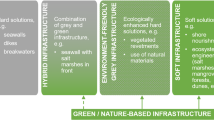Abstract
The coastal infrastructures are generally designed for 50 years or more, but often, these structures lose the functionality and need repair or retrofit within its design life. It may be due to the damage or deterioration of the concrete or embedded reinforcement. The structures are usually designed for environmental loads, but the structure is subjected to early deterioration due to the change in climate over the years. In this paper, an attempt is made to understand the effect of climate change in the rapid deterioration of structure using the non-destructive test measurements and well-established models. The study was conducted on a berthing structure located in the backwaters along the west coast of India. The deterioration of coastal structures is mainly of chloride-induced or carbonation. Both these processes depend upon parameters like temperature, relative humidity, CO2 concentration, and rainfall, etc., which in turn, changes with change in the climate. It is found from the study that the effect of climate change is present in the deterioration of the berthing structure. The concentration of chlorides and the carbonation are found to be more than that due to the natural processes of aging.










Similar content being viewed by others
References
P.T. Bhaskar, Aging Effects on Structural Concrete and Long term storage of Spent Nuclear Fuel in DCSS at ISFSIs in the USA. Manchester, UK, Division 9, Paper ID 185. (2015)
Peter Shaw, Assessment of The Deterioration of Concrete in NPP - Causes, effects and investigative methods. In: Proceedings of the Joint European commission, Organisation for Economic Co-operation and Development, International Automic Energy Agency, Vol. 3, No. 2. (1998)
X.J. Gao, X.Y. Wang, Impacts of global warming and sea level rise on service life of chloride exposed concrete structures. Sustainability 9, 460 (2017)
J. Peng, H. Tang, J. Zhang, C.S. Cai, Numerical simulation on carbonation depth of concrete structures considering time- and temperature-dependent carbonation process. Adv. Mater. Sci. Eng. (2018). https://doi.org/10.1155/2018/2326017
M. Collepardi, A. Marcialis, R. Turriziani, Penetration of chloride ions into cement paste and concrete. Am. Ceram. Soc. 53, 534–535 (1972)
X.Y. Wang, H. Lee, S. Kwon, Analysis of service life of cracked marine concrete considering global warming and Bruun rule. Int. J. Sustain. Build. Technol. Urban Dev. 9(2), 61–73 (2018)
J. Wu, M.D. Jean-Baptiste, W. Chengyong, Z. Xiaoxiong, Experimental and numerical modeling of chloride diffusivity in hardened cement concrete considering the aggregate shapes and exposure-duration effects. Results Phys. 7, 1427–1432 (2017)
S.K. Verma, S.S. Bhadauria, S. Akhtar, Estimating residual service life of deteriorated reinforced concrete structures. Am. J. Civil Eng. Arch. 1(5), 92–96 (2013)
E.M. Robert, A.C. Igor, Service life estimation of concrete infrastructure, Chapter 2 of Eco-efficient repair and rehabilitation of concrete infrastructures, Elsvier Ltd. (2018)
M.U. Khan, S. Ahmad, H.J. Al-Gahtani, Chloride induced corrosion of steel in concrete: an overview on chloride diffusion and prediction of corrosion initiation time. Int. J. Corros. (2017). https://doi.org/10.1155/2017/5819202
U.M. Tarek, I.M. Nazrul, K.S. Sudhir, R.C.M. Habibur, H. Ariful, M.K. Jamal, Carbonation coefficient of concrete in Dhaka City. Third International Conference on Sustainable Construction Materials and Technologies.(2013)
E. Mona, R.M. Ashraf, M.K. Eslam, The role of relative humidity and cement type on carbonation resistance of concrete. Alex. Eng. J. 58, 1257–1264 (2019)
Life-365 Service life prediction model. Version 2.2.3 2018.
J. Peng, M.G. Stewart,carbonation-induced corrosion damage and structural safety for concrete structures under enhanced greenhouse conditions, centre for infrastructure performance and reliability, Research Report No. 270.11.2008. ISBN No. 9780 9805 0355 5. (2008)
Indian standard code of practice for non-destructive testing of concrete-method of test (Ultra sonic pulse velocity) I.S. 13311–1:1992 Bureau of Indian standard (BIS).
ASTM C876–09, Standard test method for half-cell potentials of uncoated reinforcing steel in concrete, ASTM International, West Conshohocken, (2009)
Indian standard code of practice for non-destructive testing of concrete-method of test (characteristic strength, chemical composition and ph of concrete) I.S. 456–2000 Bureau of Indian standard (BIS)
Z.T. Woubishet, S. Esko, Service life prediction of repaired structures using concrete recasting method: state-of-the-art. Procedia Eng. 57, 1138–1144 (2013)
Copernicus Climate Change Service (C3S), 2017: ERA5: Fifth generation of ECMWF atmospheric reanalyses of the global climate. Copernicus Climate Change Service Climate Data Store (CDS), 12th March2020.https://cds.climate.copernicus.eu/cdsapp#!/home
Y. Bo, L. Jianbo, L. Bing, Improved numerical model for steel reinforcement corrosion in concrete considering influences of temperature and relative humidity. Constr. Build. Mater. 142, 175–186 (2017)
E. Bastidas-Arteaga, S. Franck, G.S. Mark, W. Xiaoming, Influence of global warming on durability of corroding RC structures: a probabilistic approach. Eng. Struct. 51, 259–266 (2013). https://doi.org/10.1016/j.engstruct.2013.01.006
Acknowledgements
This study is a part of the research project bearing the number DST/CCP/CoE/141/2018(C), funded by Department of Science and Technology under SPLICE—Climate Change Program.
Author information
Authors and Affiliations
Corresponding author
Additional information
Publisher's Note
Springer Nature remains neutral with regard to jurisdictional claims in published maps and institutional affiliations.
Rights and permissions
About this article
Cite this article
Santosh Kumar, B., Sannasiraj, S.A. & Murali, K. Effect of Climate Change in the Deterioration of a Berthing Structure in a Tropical Environment. J. Inst. Eng. India Ser. A 102, 697–703 (2021). https://doi.org/10.1007/s40030-021-00532-1
Received:
Accepted:
Published:
Issue Date:
DOI: https://doi.org/10.1007/s40030-021-00532-1




